|
Today in New Orleans History |
|
|
January 12


 Clark
Mills was born on December 13, 1810 and died on January 12, 1883 at the age of 72.
 

To receive an update for each day in New Orleans history,
join our facebook page - Today in New
Orleans History
On Monday, June 13, 2005, the U.S. Senate approved a resolution apologizing for its failure to enact federal anti-lynching legislation throughout its history. Resolution 39 called for the lawmakers, for the first time in U.S. history, to apologize to lynching victims, survivors and their descendants. Senator Mary Landrieu said, just prior of the legislators' poll, "There may be no other injustice in American history for which the Senate so uniquely bears responsibility". Over 4,700 people from 1882 to 1968, most of them black men, where recognized for having been unlawfully murdered while government officials shut their eyes to the atrocities. They included Charlotte Morris and Patrick Morris of Jefferson Parish who were lynched on this date, January 12, 1896 for miscegenation. A list of other Louisiana citizens who were included.
His mother died when he was only twelve years old, after having sold out the small stock of goods at the
French Market. Martin Behrman, later secured a place as cashier at $15.00 per month at Samuel’s Dollar Store on Canal
Street. In 1878 Mr. Michael Gallagher of Algiers, Louisiana offered him a position as grocery clerk. He left Gallagher
to work for James Lawton, father of Peter Lawton, in a large mercantile establishment which included a grocery, a bakery
and did considerable business with the planters along the river. At the age of 22, he met Miss Julia
Collins of Cincinnati, Ohio, whom he married in 1887. About that time he went into the retail grocery business with Peter
Lawton, in Algiers. He soon gave up this business and became a city salesman for Nathaniel D. Wallace and Napoleon Bonaparte
Van Horn, wholesale dealers in produce. His last business connection was with the firm of C. Doyle & Co.
Through the influence of Colonel Charles C. Bird of Baton Rouge, Mr. Behrman ran for the office of State
Auditor and was subsequently elected. In 1904 he was elected Mayor of the City of New Orleans for the first time. He took
office on November 6, of that year. His second term as mayor began on November 3, 1908 and his inauguration took place
on December 7, 1908. Mayor Behrman was again elected for his third term on October 2, 1912. He took office on December
1, 1912 and his term expired December 4, 1916. He was elected for the fourth time without opposition on November 7, 1916,
and remained in office until December 6, 1920 when Andrew J. McShane became Mayor of the city. Again in 1925, Martin Behrman
ran for mayor being opposed by Paul H. Maloney and Andrew J. McShane. A second primary became necessary owing to the closeness
of the count, but was not called due to Mr. Maloney withdrawing from the race. Martin Berhman was conceded the election on
Monday, April 13, 1925, taking office May 4, 1925. In 1912 a new City Charter
was made, which was a return to the administrative system; the offices being Mayor and Four commissioners, a system known
as “The Commission Form of Government.” Under its provision the Council was done away with and the authority
of the City Administration vested in the officers which were as follows: Mayor, Commissioner of Public Finance, Commissioner
of Public Safety, Commissioner of Public Utilities and Commissioner of Public Property. It also provides that, should
the elective mayor die while in office or resign, the Commissioner of Finance would automatically succeed to the office. During the tenure of Mayor McShane’s administration, Martin Behrman engaged in the machinery and
ship repair business and also became an officer in the American Bank. He retired as leader of the
Regulars, now the “Old Regulars,” but continued to take an active interest in politics.
Backing Fuqua for Governor from start to finish, the victory brought renewed prestige, a confidence that centered around
him personally, and that enabled him to hold the vital parts of the organization together when some of the ward leaders
headed by Paul H. Maloney broke away from the caucus. At first reluctant, because his family objected
to his submitting himself to the rigors of another campaign, as a candidate, he finally gave in to the urgings of his friends,
and entered the lists for the fifth time. He was opposed by Mr. Maloney and in a brief, vigorous
campaign definitely wrote ”Success” to the comeback fight he had been carrying on for almost five years. Mr.
Behrman was inaugurated May 4, 1925. Victory made a new man out of Martin Behrman. He was deeply
thankful to the people of New Orleans for the confidence their action in returning him to the City Hall as Mayor a fifth
time bespoke. And for New Orleans, for his organization and for himself, he was ambitious to carry through the next five
years a program of civic and governmental progress that would provide the brightest of the many bright pages in the City’s
history. This was the urge that drove him to attempt in his sixties a schedule of work that would
have taxed the unlimited energies he had in the thirties. It was that urge, as matters turned out, that killed him. A sufferer of chronic appendicitis, with a degeneration of the heart muscles, caused by over work, he
died a martyr to New Orleans. He passed away January 12, 1926, at 7:00 A.M., at
the age of sixty-one, at his home in Algiers, being survived by his widow, a son Stanley Behrman and a daughter Helen May
Behrman, wife of Nathaniel W. Bond. His body lay in state at the City Hall viewed by twenty thousand grief stricken people.
Nothing in words could visualize the immensity of the intensity of New Orleans’ last farewell to the man who was just
beginning a fifth term as its chief executive. Only once before in the City’s history was there anything to compare
with it – the funeral of the beloved Jefferson Davis, President of the Confederacy. Religious
rites were held at the St. Louis Cathedral, on January 13, 1926 at 10:30 A.M., under a white canopy, in a sea of cut flowers,
Martin Behrman was laid to rest in Metairie Cemetery. (From the New Orleans Public Library) |
|
|

To receive an update for each day in New Orleans history,
join our facebook page - Today in New
Orleans History.
Analytics |
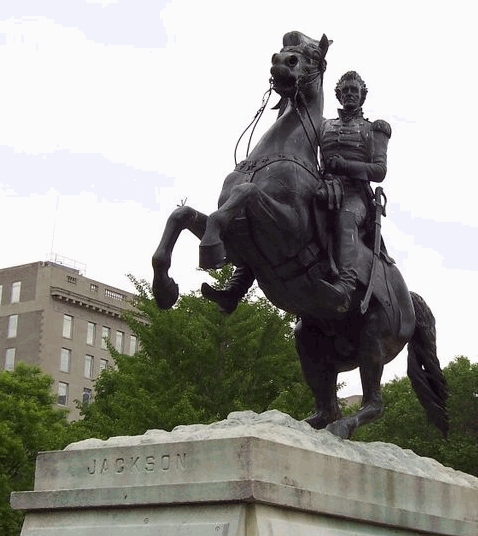 In 1848, Clark Mills (the first American sculptor of prominence not to be trained in Rome) won a commission
from the Jackson Monument Committee in Washington, D.C.for a full-scale fourteen-foot, equestrian
figure of Andrew Jackson to be placed in Lafayette Square, opposite the White House. This figure (pictured
on the right) was unveiled on January 8, 1853 ( the 38th anniversary of the Battle of New Orleans) to great
acclaim.
In 1848, Clark Mills (the first American sculptor of prominence not to be trained in Rome) won a commission
from the Jackson Monument Committee in Washington, D.C.for a full-scale fourteen-foot, equestrian
figure of Andrew Jackson to be placed in Lafayette Square, opposite the White House. This figure (pictured
on the right) was unveiled on January 8, 1853 ( the 38th anniversary of the Battle of New Orleans) to great
acclaim. 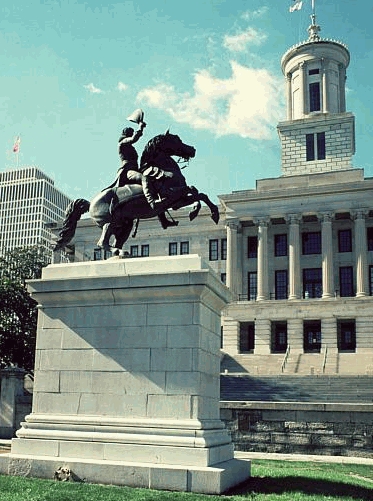
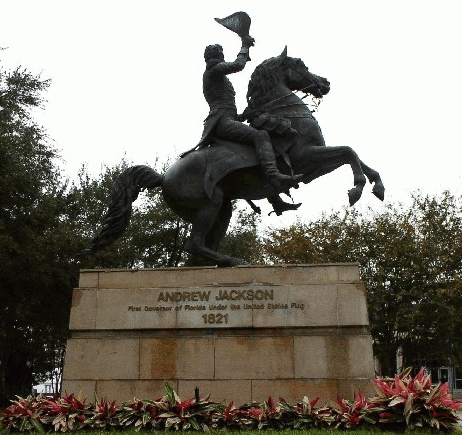
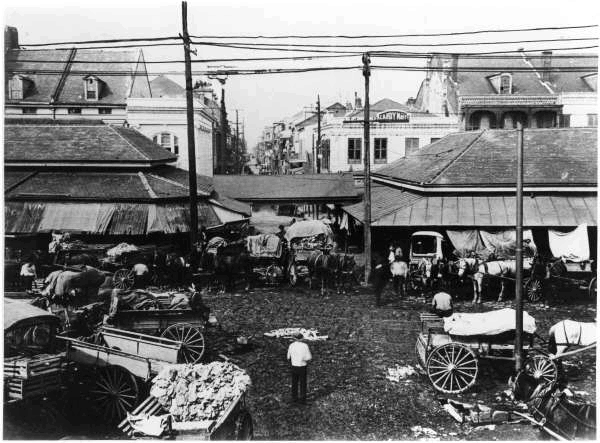
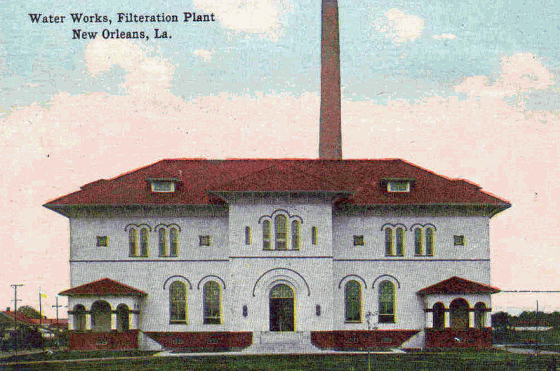 His first political association was as secretary of the Algiers Campaign Committee for Francis T. Nicholls in 1888. He later
became deputy assessor but lost this position due to a political turnover. He then went to work as a solicitor for the
Edison Electric Light Company but soon secured another political position, the assessorship for Algiers. For four years
he served as president of the Board of Assessors and then became clerk to three committees of the City Council during the
administration of Mayor John Fitzpatrick, 1892, 1896. He also was a member of the Orleans Parish School Board from 1982
to the time he became an ex-officio member in 1904. In 1898 he was one of the delegates to the Constitutional Convention.
His first political association was as secretary of the Algiers Campaign Committee for Francis T. Nicholls in 1888. He later
became deputy assessor but lost this position due to a political turnover. He then went to work as a solicitor for the
Edison Electric Light Company but soon secured another political position, the assessorship for Algiers. For four years
he served as president of the Board of Assessors and then became clerk to three committees of the City Council during the
administration of Mayor John Fitzpatrick, 1892, 1896. He also was a member of the Orleans Parish School Board from 1982
to the time he became an ex-officio member in 1904. In 1898 he was one of the delegates to the Constitutional Convention.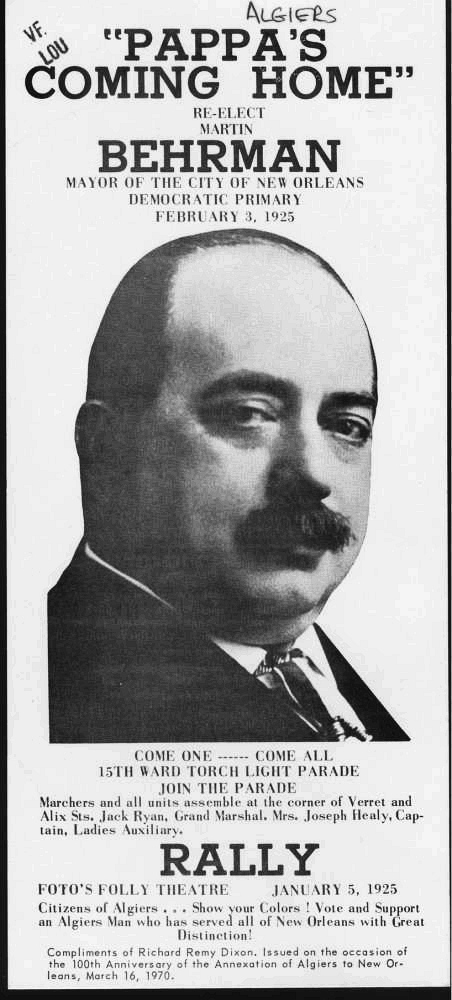 During Mr. Behrman’s long administration many old obstacles were overcome and the city made considerable progress in
improvements along various lines. The Sewerage System and the Purification Plant, whose six hundred miles of water mains
through which the finest and purest of water in the world was brought to the property line of 80,000 homes, were constructed.
The Public School System enjoyed great progress. The development of the Public Belt Railroad, the docks, Public Cotton
Warehouses and Elevators give credit to Mr. Behrman’s stewardship.
During Mr. Behrman’s long administration many old obstacles were overcome and the city made considerable progress in
improvements along various lines. The Sewerage System and the Purification Plant, whose six hundred miles of water mains
through which the finest and purest of water in the world was brought to the property line of 80,000 homes, were constructed.
The Public School System enjoyed great progress. The development of the Public Belt Railroad, the docks, Public Cotton
Warehouses and Elevators give credit to Mr. Behrman’s stewardship.
